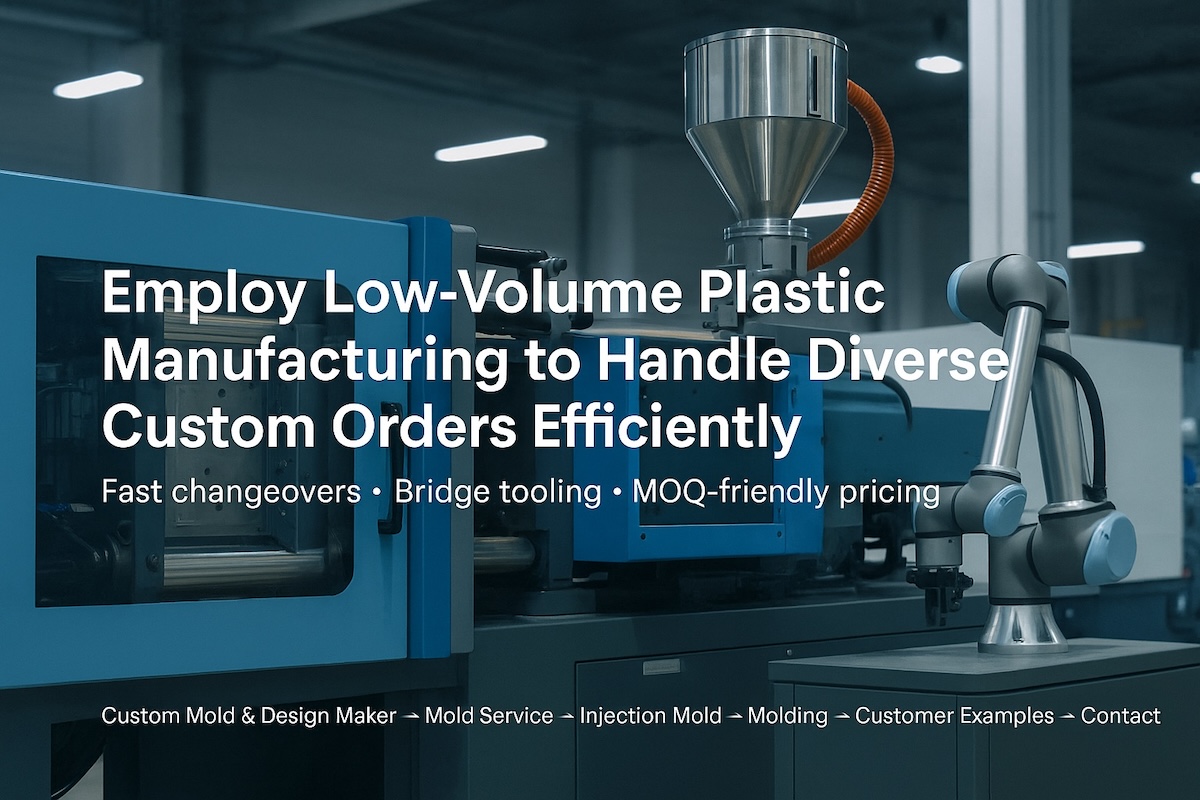Employ Low-Volume Plastic Manufacturing to Handle Diverse Custom Orders Efficiently
Employ Low-Volume Plastic Manufacturing to Handle Diverse Custom Orders Efficiently

Employ Low-Volume Plastic Manufacturing to Handle Diverse Custom Orders Efficiently
Fast changeovers • Bridge tooling • MOQ-friendly pricing
Not every project needs a 16-cavity steel tool and a million parts. When you’re validating a market, supporting multiple variants, or keeping legacy equipment in service, low-volume plastic manufacturing gives you speed, flexibility, and lower risk—without compromising quality. Use this guide—and the TaiwanMoldMaker.com network—to stand up small runs quickly and scale when demand takes off.
Explore our end-to-end services:
Custom Mold & Design Maker → Mold Service → Injection Mold → Molding → Customer Examples → Contact
What counts as “low volume”?
-
Typical order sizes: 20–10,000 pieces per SKU, with on-demand replenishment.
-
Use cases: Pilot builds, market validation, frequent design refreshes, seasonal SKUs, EOL (service) parts, niche B2B components.
-
Goal: Minimise upfront investment and time-to-first-article while maintaining repeatable, measurable quality.
Manufacturing paths that keep you fast (and sane)
1) Low-volume injection molding (preferred for production-grade parts)
-
Bridge tools: Aluminium or hybrid steel single-cavity; interchangeable inserts for variants.
-
MUD frames / insert tooling: Share a common base to cut cost and speed changeovers.
-
Hand-loads over slides: For small quantities, hand-loaded cores often beat complex side actions.
-
Copy-cavity ready: When demand spikes, we clone cavities into steel for scale.
2) CNC trim/post-machining
-
Add tight features or threads after molding to avoid expensive tooling details.
3) Color & finish agility
-
Quick masterbatch swaps, texture plates, and removable cosmetic inserts let you run short, SKU-rich batches.
DFM for low-volume success
-
Consolidate parts where possible; design shared bodies with swap-in inserts for logo/text/ports.
-
Wall uniformity & radii reduce cycle time and cosmetic risk; target 1.5–3.0 mm for most commodity resins.
-
Draft generously (≥1–2°; more for textures/soft materials) to ensure easy ejection on short runs.
-
Gate selection: Edge/fan gates for simplicity; valve gate only if vestige/cosmetics require it.
-
Steel choice: H13/420SS for longevity; Aluminium + hard inserts for bridge tools.
-
Tolerances: Lock criticals with GD&T; consider post-machining for µ-level dimensions.
Materials that fit low-volume economics
-
PP/PE/ABS/PC-ABS for housings, clips, caps—good cosmetics and cost.
-
PC/COC/COP for clarity and optics; specify UV/impact grades if needed.
-
PA6/PA66 + GF for structural brackets; dry properly to maintain properties.
-
TPE/TPU overmold for grips and seals; design mechanical locks (not just chemistry).
-
Ask us about food-contact, FR (UL 94), and medical grades where compliance is required.
Changeover playbook (how we run mixed SKUs efficiently)
-
SMED-style mold swaps: Quick-clamp plates, standard water/electrics, color-flush SOPs.
-
EOAT quick-change: Common robot frames with swappable grippers.
-
Pre-staged materials/dryers with barcoded recipes; MES tracks OEE, scrap, CpK, energy (kWh/kg) per job.
-
Vision-assisted setup and cavity-pressure sensors for first-time-right T0/T1s even on small batches.
Example timeline (pilot → first shipment)
-
Day 0–2: 48-Hour DFM pack (flow/cool/warp, cycle model) + risk log → approval
-
Day 3–10: Build Al/MUD tool; texture/polish; fixture prep
-
Day 11–13: T0 in production resin; gate-freeze + weight ladder; cosmetic tune
-
Day 14–15: T1 pilot; FAIR + CMM/scan; ship first articles
-
Day 16+: On-demand batches; copy-cavity proposal if demand >10k
Need quick-cut steel first? Plan Day 3–20/28 depending on complexity/cavitation.
When to pick low-volume vs. jump to scale
| Situation | Low-Volume Molding | Multi-Cavity Steel |
|---|---|---|
| Demand uncertain / variant-heavy | Best choice: fast, flexible, lower NRE | Over-investment risk |
| Tight launch window | Bridge tools hit dates | Longer build/validation |
| Cosmetic prototypes → saleable parts | Yes, production resin/finish | Yes, but slower to first ship |
| Unit cost priority at >50k/yr | Acceptable in pilots | Best for cost per unit |
Cost model (what to expect)
-
NRE/tooling: Lowest with MUD/Al; add inserts for variant text/logos.
-
Piece price: Higher than mass production, but offset by no excess inventory and fewer engineering loops.
-
Milestones: Tool kick-off → T0 → T1/FAIR → SOP (milestone payments align with deliverables).
-
Ownership: Tool and CAD/IP remain customer-owned per contract.
RFQ checklist (copy/paste to prevent rework)
-
Target T1 ship date and must-hit gates (DFM/T0/T1/SOP).
-
Volumes by SKU (pilot, quarterly forecast, EOL spares).
-
CAD (STEP/IGES) + 2D with CTQs/GD&T; cosmetic map & texture codes.
-
Material(s) and alternates (UL/food/medical/UV/FR requirements; color standard).
-
Tooling preference: MUD/Al/hybrid steel; hand-loads vs slides; interchangeable inserts needed?
-
Quality package: FAIR, CMM/scan, CpK targets, vision SPC; PPAP/IQ-OQ-PQ if regulated.
-
Packaging & logistics: Lot size, labels/barcodes, export pack, Incoterms; FA courier path.
-
Data access: MES dashboards for OEE, CpK, scrap, kWh/kg, and genealogy.
Send your package here → Contact
Why TaiwanMoldMaker.com for low-volume runs
-
One accountable owner from DFM to SOP.
-
Standardised, robot-ready cells with quick-change tooling and EOAT.
-
Audit-ready data for remote approvals and stakeholder updates.
-
Bridge-to-scale path: Copy-cavity to multi-cavity steel when you’re ready.
Start here:
Injection Mold → Molding → Mold Service → Customer Examples → Contact








